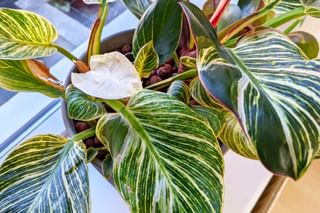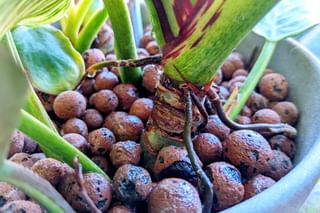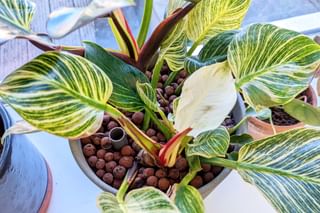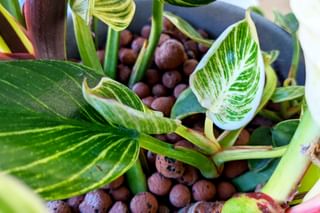How to grow a Philodendron Birkin in Leca
A Philodendron Birkin is an unusual looking plant with bright white stripes on its leaves. It's a plant that loves to dry out before it's watered again, which makes it a great plant to be planted in Leca. In this plant care guide, we're going to discover how you can take care of your Philodendron Birkin when it's planted in Leca.

Leca, Lightweight Expanded Clay Aggregate, is a great way to water your plants without worrying about overwatering them. Leca is soil-less growing medium that consists of a collection of baked clay balls. The baked clay balls soak up moisture from a layer of water at the bottom of the pot and water your Philodendron Birkin for you. If you're a person that tends to overwater your plants, Leca will help you to keep your plants healthy. So let's grow our Philodendron Birkin in Leca and help it stay healthy for years to come!
In this plant care guide, we're going to discover how you can take care of your Philodendron Birkin when it's planted in Leca. These are the things we're going to look at:
- Why would you use Leca with a Philodendron Birkin?
- Preparing your Philodendron Birkin for use in Leca
- Planting your Philodendron in Leca
- Watering your Philodendron Birkin in Leca
- Fertilizing your Philodendron Birkin in Leca
Assumptions for this plant care guide
If you're following along with this plant care guide, here are a few assumptions that I'm making:
- You've cleaned your Leca. If not, have a look at: How to prepare Leca for first use
- You have 2 pots, one with drainage holes and one that can hold water
- You have cleaned these 2 pots with soap. If not, have a look at How to clean your pots for use with Leca
Now that you've cleaned your Leca and the pots you're going to use, we're ready to move our Philodendron Birkin from soil to Leca. Let's help your plant thrive in your house and make your life a little easier!
Why would you use Leca with a Philodendron Birkin?

Leca is a collection of baked clay pebbles that soak up the moisture that's sitting at the bottom of a water holding pot. The clay pebbles evenly distribute moisture throughout the pot. This evenly distributed moisture helps to water the plants more consistently and helps your plant to stay healthy throughout the whole year. Leca is a growing medium like soil, but unlike soil, is not an "alive" growing medium. All it is, is baked clay balls that soak up moisture easily.
So why would you use this growing medium that doesn't provide your plant with any nutrients? There are a few great reasons why Leca is great for your Philodendron Birkin:
- Leca is not alive, so there is less risk of attracting pests
- Leca helps to prevent overwatering your plant
- Leca helps to keep oxygen flowing to your plant's roots
As you can see, when you grow your Philodendron Birkin in Leca, you'll have a much easier time to keep the plant healthy and thriving. You don't have to worry about watering too much and your Philodendron Birkin is less at risk of suffering from pests.
Preparing your Philodendron Birkin for use in Leca
In this guide we're going to repot our Philodendron Birkin from soil to Leca. The very first step in this process is to take the plant out of the pot and removing (almost) all the soil from your Philodendron's roots. We have to clean the soil off the roots of your plants, because soil that's wet all the time attracts pests. By cleaning the soil off the roots completely, you're giving your plant the best chance to succeed in Leca.
When you take your plant out of the pot, it's going to be a little messy, so it's best to get a towel or a bucket ready to catch the soil. With the towels or bucket ready, we can carefully take the plant out of the pot. You'll most likely see some loose soil around your plant's roots, you can carefully scrape this off the roots. During this first step, it's all about removing as much soil as possible. You don't have to scrub the roots clean, because that's the second stage of this process.
When you've removed most of the soil of the roots of your Philodendron, you'll notice it's getting more difficult to get the soil off the roots. At this point, you can get a bucket of lukewarm water to put your plant into. The soil will soak up the water and it'll be much easier to remove. Be sure to only use your hands to clean the roots of your Philodendron, because that will reduce the damage to the roots. You don't have to scrub your Philodendron's root completely clean, as long as the amount of soil is minimal.
Now that the soil is off your Philodendron's roots, the Leca is clean, and the pots are clean, we're ready to plant your Philodendron Birkin in Leca.
Planting your Philodendron in Leca
We're at the exciting part of repotting your plant in Leca: Actually planting your plant in Leca. This process is only 2 parts:
- Creating a base layer of Leca
- Planting your Philodendron Birkin in Leca
In the introduction, I've mentioned that we'll be working with 2 pots: a plastic pot with drainage holes and a water holding pot. In this step, we'll only need the plastic pot with the drainage holes as this is where your Leca will sit and your plant will live.
The plastic pot with drainage holes is very likely the same pot your plant came in when you bought it at the store. These pots have many uses and if you've kept them around for a while, now they'll come in handy.
Creating a base layer of Leca
To get started, we'll need to add a base layer of Leca. This base layer is vital for growing your plant in Leca, because it keeps your plant healthy in 2 ways:
- It lifts the Philodendron off the bottom of the pot where the water will sit
- It soaks up the moisture at the bottom of the pot
Because this base layer lifts the plant off the bottom of the pot, it makes sure your plant never sits in water. When your plant sits in water for a longer period of time, it will be overwatered and could get root rot. The base layer prevents the overwatering, and allows the Leca to soak up the water at the bottom of the pot to water your plant for you.
The base layer of Leca should be at least 2.5 cm (1 inch), but ideally you want the base layer to be 5 cm (2 inches). This makes it much less likely that you'll ever overwater your plant. When you've added the base layer make sure you remember where the top of your base layer is. You might even be able to mark the top of the base layer on the outside of the plastic pot with drainage holes.
Planting your Philodendron Birkin in Leca
Now that the base layer of Leca is in place, you can plant the Philodendron Birkin. Planting your plant in Leca is quite straightforward: Put clay balls around your plant until you get to the edge of the plastic pot. The only thing you have to keep in mind is that you should cover the roots in at least 2.5 cm (1 inch) of Leca. Most roots don't like sunlight exposure and will dry up and die. To prevent your roots from drying up, you'll need to keep sunlight away from it by covering it in Leca.
How do you water your Philodendron Birkin in Leca?
Now the most fun part (for me) of growing your Philodendron Birkin in Leca starts: Watering your plant. Watering a plant that's growing in Leca is a little different from watering a plant that's growing in soil. When you're growing your plant in soil, having a drainage hole is vital to keep your plant healthy. When you're growing your plant in Leca, the last thing you want is for the water to escape the pot.
In the previous section, we've created a base layer of Leca at the bottom of the plastic pot with drainage holes. This base layer is very important for keeping your plant healthy in Leca, because it'll lift your plant out of the layer of water at the bottom of the pot. It's also there to soak up the water from the bottom of the pot and distribute the moisture throughout the entire pot. The base layer lifts the plant out of the water, so it's important that you know where the base layer ends and the plant starts. When you water the plant, the layer of water should never go above the base layer of Leca, because this will put the plant at risk of overwatering. As long as you keep the water level below the base layer, you will never overwater your plant in Leca.
Watering your plant in Leca is easy, because all you have to do is add water with special fertilizer to the outer, water holding pot and keep the layer of water below the base layer. You don't have to think about how you water your plant (from the top or bottom for example) like you do with soil. As long as the water gets in the pot, the Leca will soak it up and water your plant for you.
When do you have to water your Philodendron in Leca?
When you notice that the Leca in the inner pot with the drainage holes is no longer touching the water layer at the bottom, you can water your plant again. The Leca in the base layer needs to sit in the water to be able to soak up the moisture. If it's not sitting in the water any more, it can't water your plant. So as soon as you notice that the water layer is too low for your Leca to soak it up, you can add more water. You don't have to wait until the clay balls are dry before watering.
How do you fertilize your Philodendron Birkin in Leca?
We've already discovered that Leca is a collection of baked clay balls and is not a growing medium that's "alive". When you're using soil to grow your plants, you'll probably have fertilized your plants before. This type of fertilizer is specifically designed to feed your plant when it's planted in Leca. Since Leca is just a collection of clay balls and doesn't contain any nutrients by itself, you have to add it separately.
Fertilizing your Philodendron Birkin in Leca and watering is the same thing. When you're using Leca, you'll have to add the nutrients your plant needs to grow to the water. This fertilizer is specifically designed to be used in a hydroponic growing environment. Hydroponics is a term for growing your plants without using any soil. This type of fertilizer doesn't rely on any soil to provide the plant with nutrients, so it contains all the nutrients your plant needs.
All fertilizer is different, so it's important to follow the instructions on the bottle you get. In my experience, you need to use 1 ml of fertilizer per 1000 ml of water, but the instructions for your fertilizer might be different. After you've mixed the fertilizer and water, you can water your plant like we've already looked at in the previous section. It's important to add the nutrients every time you water your plant, because it's the only food source for your Philodendron in Leca.
Conclusion
A Philondendron Birkin is a beautiful and unusual looking houseplant that's low-maintainance. It likes to dry out before being watered again, which makes it a perfect plant to grow with Leca. Taking care of a plant in Leca is quite easy and very low-maintainance, so it's perfect for busy plant owners. When you're using Leca with your Philodendron Birkin, you're less likely to overwater your plant, there is less risk of attracting pests, and this keeps your plant very happy and healthy for a long time.
If you'd like to learn more about Leca, you can read more about the entire process of repotting and growing plants in Leca.
Thank you for reading this post! I hope it helps you to keep your plants healthy and beautiful! If you're looking for more guides on specific plants, you can always request a plant guide to get a guide for the plant you have trouble with.
Test your plant care knowledge
Quiz completed!
Want to learn more? Sign up for my newsletter to receive free tips in your inbox!
Sign up now!









